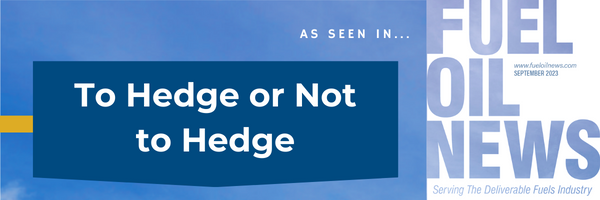When considering whether to hedge (or not to), it is important to review the following key factors.
- Variable Cost Structure: Your variable cost structure includes items like driver payroll (particularly part time and seasonal) that can be reduced with lower levels of business in a warm winter. You will want to estimate the maximum amount of payroll expense that can be cut in a warm winter, without losing valuable employees. Then, based upon your forecasted unit margin, calculate the number of gallons represented by the maximum amount of your payroll cut. This tells you what percentage decrease in gallons can be offset by payroll cuts without eating into profitability.
- Fixed Cost Structure: Your fixed cost structure includes items like overhead payroll, insurance, and rent. These are expenses that do not come down with reduced levels of business in a warm winter. Due to the seasonality of the fuel distribution business, many dealers experience losses in the offseason, even in a normal winter. Therefore, when considering the profit impact of a warm winter, it is important to understand how much additional loss can be absorbed while still allowing you to keep up with your fixed costs. This can be done through a detailed analysis of your company’s fixed cost structure.
- Inflation: Inflation rates have come down significantly after hitting historic levels over the past two years. However, recent measurements of the Consumer Price Index (CPI) have remained above the Federal Reserve’s (Fed) target level. Your costs will continue to rise based upon the CPI levels. As prices are rising, inflation must be considered when calculating your company’s ability to maintain your fixed cost structure, as well as your ability to purchase fixed assets like computers, vehicles, and steel tanks.
- Interest Rates: As of the July 2023 Fed meeting, benchmark interest rates have reached the highest level in more than 22 years. Because inflation rates are still above the Fed’s target, it is likely that interest rates will continue to increase. As a result, your company’s variable rate debt has gotten much more expensive since March 2022, and it will continue to get more expensive. Calculate the annual impact of this increase based upon current interest rates. Strain on profit and cash flow is only worsened by the profit loss impacts of a warm winter.
These are just some of the key factors to consider when deciding whether to hedge (or not to). In addition to the quantitative factors above, you will also need to evaluate your company’s willingness and ability to remain consistent, should you decide to implement weather hedging.
Contact us today to learn how Angus Energy can help you uncover the solutions and processes needed to help you meet and exceed your goals.
The above is an excerpt from an article by Rashaan Baskerville.

